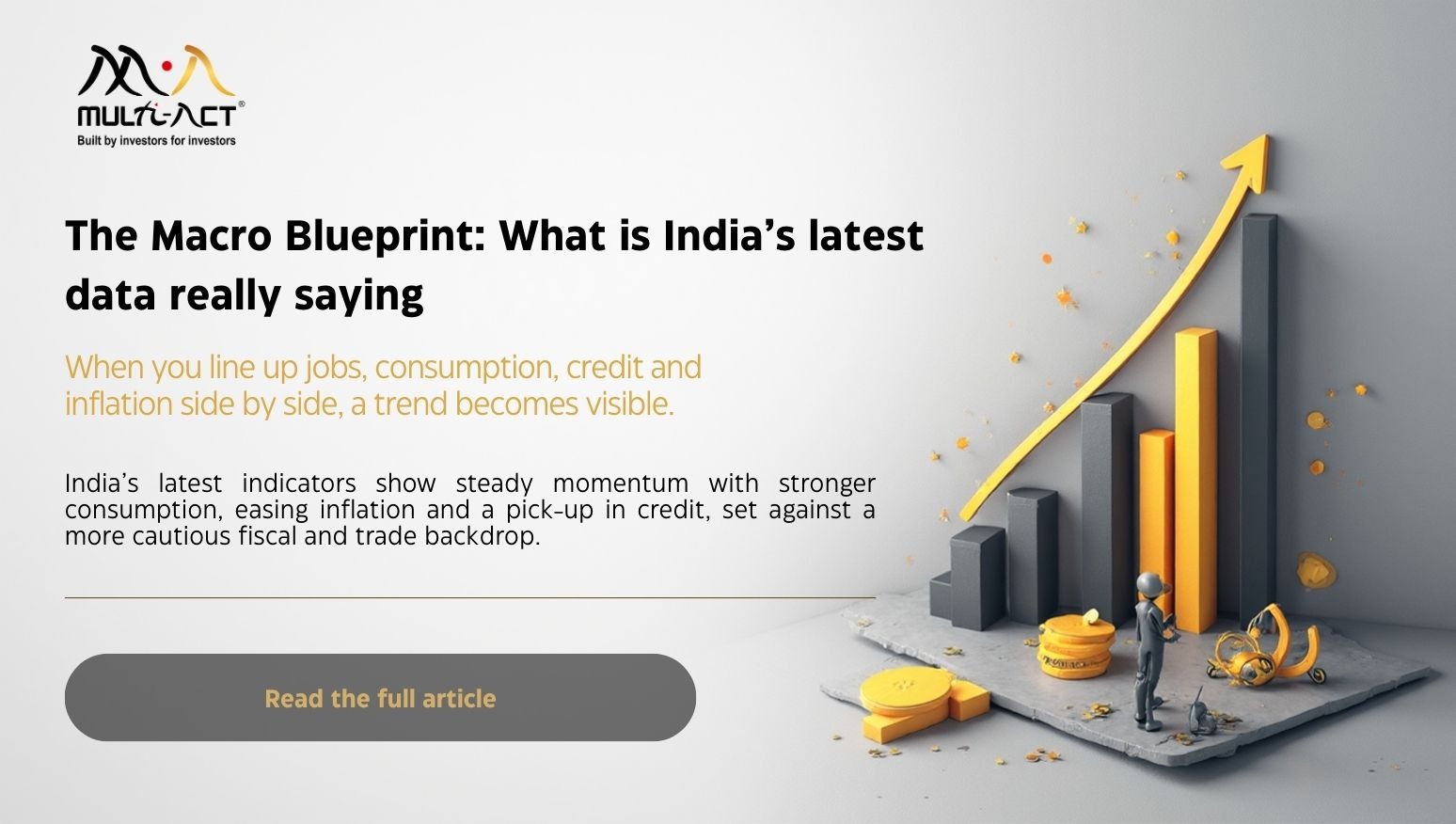
The Macro Blueprint: What is India’s latest data really saying
Macro numbers alone rarely tell the full story. When jobs, consumption, credit, and inflation are considered together, … Continued
Read more22 January 2021

I’m a big fan of test cricket.
You see, test cricket is different from other sports. Amongst other things, it’s a test of character, skill, resilience, and endurance.
It’s no wonder they say, test cricket separates the men from the boys.
I enjoy it the most when India plays against Australia, England, and South Africa. These are some of the best test cricket teams and playing on their home turf is even more challenging.
On Tuesday, we did the impossible.
We defeated Australia at ‘fortress Gabba’. This is the first time that Australia has been beaten in 32 years in this stadium. With this win, we also won the test series.
This series win is really special. It was a movie script type of a comeback.
I mean, who would have thought the series win after the Adelaide debacle? In that match, India suffered a mind-boggling batting collapse and bowled out for just 36 runs.
To add to that, our captain-Virat Kohli left the series due to paternity leave. We suffered several injuries in between. In the last match, the combined experience of our bowling attack was less than 10 test matches.
It was truly ‘India A’ playing against the full-strength Aussies in the last test match.
And boy, they played the match of a lifetime.
This game and the series taught us life lessons. The most important one was ‘Never Give Up’.
Determination, focus, hard work and leadership were some of the other key lessons that we learnt.
Apart from this, there are some important lessons for investing as well.
There will be some assets/components that will protect the portfolio from the downside, provide stability and give good returns in the long term.
In the series, Pujara was trying to protect the Indian batting line up against the most difficult Australian bowling attack. He put his body on the line and stood tall midst the entire short ball barrage.
Pujara was hit on the body or the helmet 14 times across the four-match series – that is a record for body blows received in a single series by a batsman. It was Pujara’s defiant batting that set up what was one of India’s most glorious wins.
In investing, the investors often forget the underrated but crucial role of the ability to protect the downside risk from market drawdowns in determining long-term outcomes.
Think of “Pujara” type of companies in the portfolio who could withstand storms. Let’s call them High Quality (HQ) companies which have fared better on Quantitative parameters (like ROCE, ROE, Free Cash Flow, Leverage etc) and Qualitative parameters (Corporate governance, Competitive advantage etc).
How these HQ companies perform in tough times?
Let’s look at what happened during the financial crisis of 2007-08.
Although the low Quality (LQ) index was outperforming the HQ index in the beginning, during the severe downturn, LQ index collapsed by 55%, whereas, HQ index was down by about 24%

Similarly, in terms of recovery, the HQ index was quick to rebound to its earlier starting point and that took about 220 days. Whereas, the LQ index took a whopping 315 days to recover.
The similar trend was observed during the outbreak of the Covid-19 pandemic. HQ did much better in terms of drawdown and recovery.
You can read more about recovery and drawdown here.
Allocation to such “Pujara” type of companies/assets will help to restrict drawdowns while reasonably capturing the upside, over the long period.
Another aspect of India’s victory is the talent it had on the bench, which was waiting for the opportunity. Once they (e.g., Siraj, Pant, Thakur, Sundar, Gill) got the opportunity, they showed their talent to the world. These players have already proven their talent at the domestic level.
Consider this as a “potential Small-cap/Midcap short list” which have proven track record and waiting for the big opportunity.
There are two important points that I want to highlight here.
Subject to fundamentals and valuations, even if one or two stocks from the shortlist makes it to your portfolio, this could pave the way for long-term wealth creation.
Sachin Tendulkar tweeted, “(In) Every session, we discovered a new hero”. This was the story for overall test series as well.
Whether it was Ajinkya Rahane’s century in the second match or Ashwin and Vihari’s match-saving partnership in the third match or total team effort in the last match (Pant, Pujara, Gill, Sundar, Shardul, Siraj). It was the overall team that made the difference.
Likewise, in investing, not all companies do well all the time. It is important to have a good mix of companies/assets that can do well in different time frames in different market conditions.
Having a variety of asset classes (such as stocks, bonds, gold, commodities) can ensure you are best positioned to take advantage of tailwinds in any particular year. For instance, bonds have a low correlation with stocks and can cushion against losses during market downturns. Similarly, real estate and commodities perform well during high inflation.
Whether it was Ashwin- Vihari’s match-saving partnership in the third test match or Pujara’s overall batting in the series or Pant’s match-winning knock at the Gabba, it had patience ingrained.
Although Ashwin and Vihari’s partnership only scored 62 runs in the third test, they battled for 258 deliveries to help India walk away with an epic draw and also provided the foundation for the final battle at the Gabba.
Wealth creation is a long journey with many ups and downs. There will be drawdowns and corrections. One needs to ride this journey with patience like Ashwin and Vihari did in Sydney.
Impatient investors let anxiety and emotion rule their decision-making. Focusing on short-term volatility, selling or buying at the wrong time or abandoning a long-term strategic investment plan could damage investors’ long-term returns.
Remember, Pant took time to get set, scored only 10 off his first 31 balls. He and Pujara played out four maiden overs on the trot either side of tea. For the time being, the Aussie bowlers were dominating. He let them do it only to win the Gabba battle in the end.
Pant and Washington were a part of the first batch Rahul Dravid coached. Gill and Shaw were in his second batch. It’s been nearly six years since Dravid took charge of the U-19 and India ‘A’. In essence, India’s bench strength has been built by ‘the wall’.
Dravid has bought a process-oriented approach to the grooming of youngsters. Although, the work of Dravid and other supporting staff in the background is not visible in the final outcome but it helped when mattered the most.
In investing, strong research process includes identifying and shortlisting a set of companies, further refining and filtering this universe which exhibit good balance sheet strength and have good quality of earnings characteristics.
In the Multi-Act framework, we assess companies-based Moat (such as consumer preference, economies of scale, switching cost, network effect, intangible), look at quantitative parameters such as F-Score, M-score and Z-score, grade companies based on quantitative parameters. We delve deeper into the quality of earnings, corporate governance and accounting related issues.
Once the above checks are complete, we consider investing only if the stock is in our Estimated Business Value or EBV range. To identify EBV, we consider several parameters (subject to business/industry) such as historical valuation range, valuation based on discounted cash flow, asset-based valuation, valuation based on no growth value etc. This aspect is Fundamental analysis.
Post identifying fundamentally sound stocks, determining how the company stands vis-à-vis the rest of the market and gauging whether the stock is facing “headwinds” or “tailwinds” from other participants, helps us time our investments accordingly. This is an essential timing tool and helps us determine strategic entry and exit points before we invest.
Just like the process-oriented approach of Dravid in grooming young talent, strong research process in the background goes a long way in building a good portfolio. A portfolio which not only protects the downside but also helps to capture the upside when the opportunity arises.
Happy Investing!

Macro numbers alone rarely tell the full story. When jobs, consumption, credit, and inflation are considered together, … Continued
Read more
The AI story everyone sees is technological. The story that a few notice is financial. Revolving expenditures, … Continued
Read more
Portfolios are often seen as long journeys, built patiently for compounding. Yet along the way, there are … Continued
Read moreReceive monthly updates by signing up to our newsletter.
|
Sr. No. |
Received from |
Pending at the end of last month |
Received |
Resolved* |
Total Pending # |
Pending complaints > 3 months |
Average Resolution time^ (in days) |
|
1 |
Directly from Investors |
0 |
0 |
0 |
0 |
0 |
0 |
|
2 |
SEBI (SCORES) |
0 |
0 |
0 |
0 |
0 |
0 |
|
3 |
Other Sources (if any) |
0 |
0 |
0 |
0 |
0 |
0 |
|
|
Grand Total |
0 |
0 |
0 |
0 |
0 |
0 |
Number of complaints received during month against the IA due to impersonation by some other entity:
Note: In case of any complaints received against the IA due to impersonation of the IA by some other entity, the IA may adjust the number of such complaints from total number of received/resolved complaints while preparing the above table. Further, IA must close such impersonation related complaints after following the due process as specified by SEBI/ IAASB.
* Inclusive of complaints of previous months resolved in the current month.
# Inclusive of complaints pending as on the last day of the month
^ Average Resolution time is the sum total of time taken to resolve each complaint in days, in the current month divided by total number of complaints resolved in the current month.
|
Sr. No. |
Month |
Carried forward from previous month |
Received |
Resolved* |
Pending# |
|
1 |
April, 2025 |
0 |
0 |
0 |
0 |
|
2 |
May, 2025 |
0 |
0 |
0 |
0 |
|
3 |
June, 2025 |
0 |
0 |
0 |
0 |
|
4 |
July, 2025 |
0 |
0 |
0 |
0 |
|
5 |
August, 2025 |
0 |
0 |
0 |
0 |
|
6 |
September, 2025 |
0 |
0 |
0 |
0 |
|
7 |
October, 2025 |
0 |
0 |
0 |
0 |
|
8 |
November, 2025 |
0 |
0 |
0 |
0 |
|
|
Grand Total |
0 |
0 |
0 |
0 |
*Inclusive of complaints of previous months resolved in the current month. #Inclusive of complaints pending as on the last day of the month.
|
SN |
Year |
Carried forward from previous year |
Received |
Resolved* |
Pending# |
|
1 |
2021-22 |
0 |
0 |
0 |
0 |
|
2 |
2022-23 |
0 |
0 |
0 |
0 |
|
3 |
2023-24 |
0 |
0 |
0 |
0 |
|
4 |
2024-25 |
0 |
0 |
0 |
0 |
|
|
Grand Total |
0 |
0 |
0 |
0 |
*Inclusive of complaints of previous years resolved in the current year. #Inclusive of complaints pending as on the last day of the year.